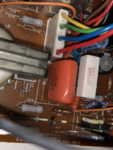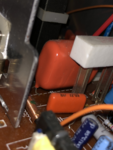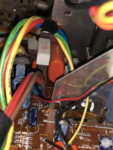horttanainen
Member level 2
- Joined
- Jul 18, 2020
- Messages
- 42
- Helped
- 0
- Reputation
- 0
- Reaction score
- 0
- Trophy points
- 6
- Location
- Helsinki, Finland
- Activity points
- 492
@Relayer I measured the voltages around TS467. Collector is 22.1 V DC, base is 0.025 V DC, and emitter 0.02 V DC.
I also tested transistor TS132. The base-emitter resistance is 0.646 * 2k ohms and base-collector resistance is 0.570 * 2k ohms. Punch through tests were ok.
@Relayer More progress. I lifted the cathode leg of D141 and connected two light bulbs (40W and 60W) in series to the anode leg. I used the negative side of C144 as grounding point as instructed. The whistling was gone. Does this rule out PSU as being the faulty component?
I also tested transistor TS132. The base-emitter resistance is 0.646 * 2k ohms and base-collector resistance is 0.570 * 2k ohms. Punch through tests were ok.
--- Updated ---
@Relayer More progress. I lifted the cathode leg of D141 and connected two light bulbs (40W and 60W) in series to the anode leg. I used the negative side of C144 as grounding point as instructed. The whistling was gone. Does this rule out PSU as being the faulty component?
Last edited:


